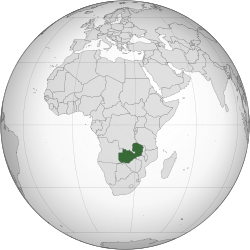| 1911–1964 | |||||||||||||
| Anthem: God Save the King/Queen | |||||||||||||
 | |||||||||||||
| Status | Territory of the British South Africa Company (1911–1924) Protectorate of the United Kingdom (1924–1953, 1963–1964) Division of the Federation of Rhodesia and Nyasaland (1953–1963) | ||||||||||||
| Capital | Livingstone (until 1935) Lusaka (from 1935) | ||||||||||||
| Common languages | English (official) Bemba, Nyanja, Tonga and Lozi widely spoken | ||||||||||||
| Government | Protectorate | ||||||||||||
| Monarch | |||||||||||||
• 1911–1936 | George V | ||||||||||||
• 1936 | Edward VIII | ||||||||||||
• 1936–1952 | George VI | ||||||||||||
• 1952–1964 | Elizabeth II | ||||||||||||
| Governor | |||||||||||||
• 1911–1921 (first) | Lawrence Aubrey Wallace | ||||||||||||
• 1959–1964 (last) | Evelyn Hone | ||||||||||||
| Prime Minister | |||||||||||||
• 1964 | Kenneth Kaunda | ||||||||||||
| Legislature | Legislative Council | ||||||||||||
| Historical era | Interwar period · Cold War | ||||||||||||
| 1911 | |||||||||||||
• British protectorate | 1 April 1924 | ||||||||||||
1953–1963 | |||||||||||||
• Independence | 24 October 1964 | ||||||||||||
| Area | |||||||||||||
• Total | 751,925 km2 (290,320 sq mi) | ||||||||||||
| Currency | Southern Rhodesian pound | ||||||||||||
| |||||||||||||
| Today part of | Zambia | ||||||||||||
Northern Rhodesia was a British protectorate in Southern Africa, now the independent country of Zambia. It was formed in 1911 by amalgamating the two earlier protectorates of Barotziland-North-Western Rhodesia and North-Eastern Rhodesia.[1][2][3][4] It was initially administered, as were the two earlier protectorates, by the British South Africa Company (BSAC), a chartered company, on behalf of the British Government. From 1924, it was administered by the British Government as a protectorate, under similar conditions to other British-administered protectorates, and the special provisions required when it was administered by BSAC were terminated.[4][5]
Although under the BSAC charter it had features of a charter colony, the BSAC's treaties with local rulers, and British legislation, gave it the status of a protectorate. The territory attracted a relatively small number of European settlers, but from the time they first secured political representation, they agitated for white minority rule, either as a separate entity or associated with Southern Rhodesia and possibly Nyasaland. The mineral wealth of Northern Rhodesia made full amalgamation attractive to Southern Rhodesian politicians, but the British Government preferred a looser association to include Nyasaland. This was intended to protect Africans in Northern Rhodesia and Nyasaland from discriminatory Southern Rhodesian laws. The Federation of Rhodesia and Nyasaland formed in 1953 was intensely unpopular among the vast African majority and its formation hastened calls for majority rule. As a result of this pressure, the country became independent in 1964 as Zambia.[6]
The geographical, as opposed to political, term "Rhodesia" referred to a region generally comprising the areas that are today Zambia and Zimbabwe.[7] From 1964, it only referred to the former Southern Rhodesia.
- ^ a b Northern Rhodesia Order in Council 1911 (SR&O 1911/438)
- ^ Barotziland-North-Western Rhodesia Order in Council, 1899, S.E.O. 1901 No. 567 (as amended, S.R.O. Rev. 1904, V.)
- ^ North-Eastern Rhodesia Order in Council 1900 (SR&O 1900/89)
- ^ a b Commonwealth and Colonial Law by Kenneth Roberts-Wray, London, Stevens, 1966. p. 753
- ^ Northern Rhodesia Order in Council 1924 (SR&O 1924/324), S.R.O. & S.I. Rev VIII, 154
- ^ Zambia Independence Act 1964 (c. 65)
- ^ "Merriam-Webster online dictionary". Archived from the original on 21 April 2009. Retrieved 25 October 2005.
Cite error: There are <ref group=lower-alpha> tags or {{efn}} templates on this page, but the references will not show without a {{reflist|group=lower-alpha}} template or {{notelist}} template (see the help page).

